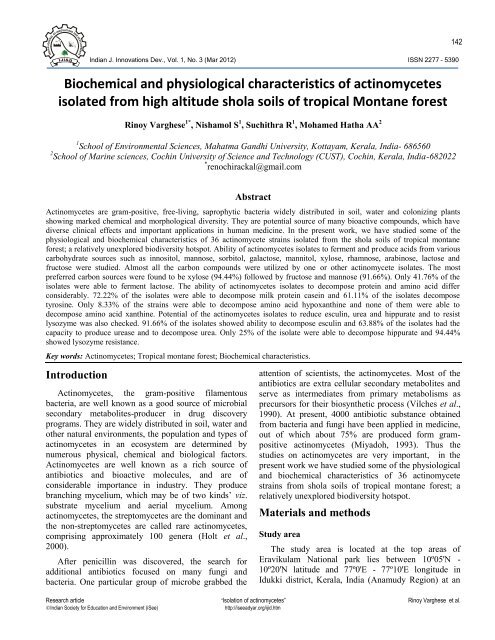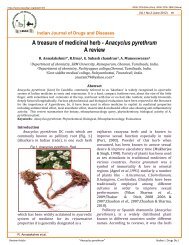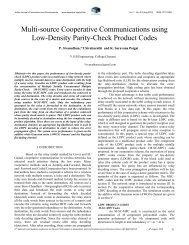Biochemical and physiological characteristics of actinomycetes ...
Biochemical and physiological characteristics of actinomycetes ...
Biochemical and physiological characteristics of actinomycetes ...
Create successful ePaper yourself
Turn your PDF publications into a flip-book with our unique Google optimized e-Paper software.
Indian J. Innovations Dev., Vol. 1, No. 3 (Mar 2012) ISSN 2277 – 5390<br />
<strong>Biochemical</strong> <strong>and</strong> <strong>physiological</strong> <strong>characteristics</strong> <strong>of</strong> <strong>actinomycetes</strong><br />
isolated from high altitude shola soils <strong>of</strong> tropical Montane forest<br />
Rinoy Varghese 1* , Nishamol S 1 , Suchithra R 1 , Mohamed Hatha AA 2<br />
1 School <strong>of</strong> Environmental Sciences, Mahatma G<strong>and</strong>hi University, Kottayam, Kerala, India- 686560<br />
2 School <strong>of</strong> Marine sciences, Cochin University <strong>of</strong> Science <strong>and</strong> Technology (CUST), Cochin, Kerala, India-682022<br />
* renochirackal@gmail.com<br />
Abstract<br />
Actinomycetes are gram-positive, free-living, saprophytic bacteria widely distributed in soil, water <strong>and</strong> colonizing plants<br />
showing marked chemical <strong>and</strong> morphological diversity. They are potential source <strong>of</strong> many bioactive compounds, which have<br />
diverse clinical effects <strong>and</strong> important applications in human medicine. In the present work, we have studied some <strong>of</strong> the<br />
<strong>physiological</strong> <strong>and</strong> biochemical <strong>characteristics</strong> <strong>of</strong> 36 actinomycete strains isolated from the shola soils <strong>of</strong> tropical montane<br />
forest; a relatively unexplored biodiversity hotspot. Ability <strong>of</strong> <strong>actinomycetes</strong> isolates to ferment <strong>and</strong> produce acids from various<br />
carbohydrate sources such as innositol, mannose, sorbitol, galactose, mannitol, xylose, rhamnose, arabinose, lactose <strong>and</strong><br />
fructose were studied. Almost all the carbon compounds were utilized by one or other actinomycete isolates. The most<br />
preferred carbon sources were found to be xylose (94.44%) followed by fructose <strong>and</strong> mannose (91.66%). Only 41.76% <strong>of</strong> the<br />
isolates were able to ferment lactose. The ability <strong>of</strong> <strong>actinomycetes</strong> isolates to decompose protein <strong>and</strong> amino acid differ<br />
considerably. 72.22% <strong>of</strong> the isolates were able to decompose milk protein casein <strong>and</strong> 61.11% <strong>of</strong> the isolates decompose<br />
tyrosine. Only 8.33% <strong>of</strong> the strains were able to decompose amino acid hypoxanthine <strong>and</strong> none <strong>of</strong> them were able to<br />
decompose amino acid xanthine. Potential <strong>of</strong> the <strong>actinomycetes</strong> isolates to reduce esculin, urea <strong>and</strong> hippurate <strong>and</strong> to resist<br />
lysozyme was also checked. 91.66% <strong>of</strong> the isolates showed ability to decompose esculin <strong>and</strong> 63.88% <strong>of</strong> the isolates had the<br />
capacity to produce urease <strong>and</strong> to decompose urea. Only 25% <strong>of</strong> the isolate were able to decompose hippurate <strong>and</strong> 94.44%<br />
showed lysozyme resistance.<br />
Key words: Actinomycetes; Tropical montane forest; <strong>Biochemical</strong> <strong>characteristics</strong>.<br />
Introduction<br />
Actinomycetes, the gram-positive filamentous<br />
bacteria, are well known as a good source <strong>of</strong> microbial<br />
secondary metabolites-producer in drug discovery<br />
programs. They are widely distributed in soil, water <strong>and</strong><br />
other natural environments, the population <strong>and</strong> types <strong>of</strong><br />
<strong>actinomycetes</strong> in an ecosystem are determined by<br />
numerous physical, chemical <strong>and</strong> biological factors.<br />
Actinomycetes are well known as a rich source <strong>of</strong><br />
antibiotics <strong>and</strong> bioactive molecules, <strong>and</strong> are <strong>of</strong><br />
considerable importance in industry. They produce<br />
branching mycelium, which may be <strong>of</strong> two kinds’ viz.<br />
substrate mycelium <strong>and</strong> aerial mycelium. Among<br />
<strong>actinomycetes</strong>, the streptomycetes are the dominant <strong>and</strong><br />
the non-streptomycetes are called rare <strong>actinomycetes</strong>,<br />
comprising approximately 100 genera (Holt et al.,<br />
2000).<br />
After penicillin was discovered, the search for<br />
additional antibiotics focused on many fungi <strong>and</strong><br />
bacteria. One particular group <strong>of</strong> microbe grabbed the<br />
Research article “Isolation <strong>of</strong> <strong>actinomycetes</strong>” Rinoy Varghese et al.<br />
�Indian Society for Education <strong>and</strong> Environment (iSee) http://iseeadyar.org/ijid.htm<br />
142<br />
attention <strong>of</strong> scientists, the <strong>actinomycetes</strong>. Most <strong>of</strong> the<br />
antibiotics are extra cellular secondary metabolites <strong>and</strong><br />
serve as intermediates from primary metabolisms as<br />
precursors for their biosynthetic process (Vilches et al.,<br />
1990). At present, 4000 antibiotic substance obtained<br />
from bacteria <strong>and</strong> fungi have been applied in medicine,<br />
out <strong>of</strong> which about 75% are produced form grampositive<br />
<strong>actinomycetes</strong> (Miyadoh, 1993). Thus the<br />
studies on <strong>actinomycetes</strong> are very important, in the<br />
present work we have studied some <strong>of</strong> the <strong>physiological</strong><br />
<strong>and</strong> biochemical <strong>characteristics</strong> <strong>of</strong> 36 actinomycete<br />
strains from shola soils <strong>of</strong> tropical montane forest; a<br />
relatively unexplored biodiversity hotspot.<br />
Materials <strong>and</strong> methods<br />
Study area<br />
The study area is located at the top areas <strong>of</strong><br />
Eravikulam National park lies between 10º05'N -<br />
10º20'N latitude <strong>and</strong> 77º0'E - 77º10'E longitude in<br />
Idukki district, Kerala, India (Anamudy Region) at an
Indian J. Innovations Dev., Vol. 1, No. 3 (Mar 2012) ISSN 2277 – 5390<br />
altitude <strong>of</strong> 1900 m to 2400 m above MSL. Most <strong>of</strong> the<br />
l<strong>and</strong> in this area is covered by grass l<strong>and</strong>s <strong>and</strong> shola.<br />
Shola forests are considered as one <strong>of</strong> the biodiversity<br />
rich ecosystem. For the present study, we selected six<br />
sites in shola forest at different altitude for sample<br />
collection.<br />
Collection <strong>of</strong> sample<br />
Soil samples were collected from prefixed six sites<br />
(SH1 – SH6) <strong>of</strong> shola forest at different altitude or<br />
different microclimate. Samples were collected at a<br />
depth <strong>of</strong> 15 to 20 cm from the surface after removing<br />
the top layer. For each <strong>of</strong> the sampling sites, subsamples<br />
<strong>of</strong> soil were collected from different locations,<br />
pooled together <strong>and</strong> homogenized so as to obtain<br />
representative sample. Sampling was carried out<br />
during post-monsoon, pre-monsoon <strong>and</strong> monsoon<br />
seasons. Samples were collected using a spade that is<br />
thoroughly cleaned <strong>and</strong> disinfected between sampling<br />
so as to prevent cross-contamination.<br />
Isolation, Enumeration <strong>and</strong> maintenance <strong>of</strong> isolates<br />
Isolation <strong>and</strong> enumeration <strong>of</strong> Actinomycetes were<br />
carried by st<strong>and</strong>ard serial dilution plate technique. 10 g<br />
<strong>of</strong> soil was transferred to in 90 ml sterile distilled water<br />
<strong>and</strong> agitated vigorously. Different aqueous dilutions,<br />
10 -1 to 10 -4 <strong>of</strong> the suspensions were prepared <strong>and</strong><br />
spread plated on Kusters Agar. Nystatin (50 μg/ml) or<br />
Amphotericin (75μg/ml) <strong>and</strong> Streptomycin (25μg/ml)<br />
were added to the isolation media in order to prevent<br />
fungal <strong>and</strong> bacterial contamination respectively. The<br />
plates were incubated at room temperature for 2 to 3<br />
weeks. After incubation Actinomycetes colonies were<br />
count <strong>and</strong> separate colonies were streaked on to Kusters<br />
Agar plates <strong>and</strong> incubated at room temperature for 4-6<br />
Percentage<br />
80<br />
70<br />
60<br />
50<br />
40<br />
30<br />
20<br />
10<br />
0<br />
Fig.1. Comparison <strong>of</strong> the ability <strong>of</strong> <strong>actinomycetes</strong> isolates<br />
to decompose casein, xanthine, hypoxanthine <strong>and</strong> tyrosine<br />
days to obtain pure cultures <strong>of</strong> Actinomycetes.<br />
Research article “Isolation <strong>of</strong> <strong>actinomycetes</strong>” Rinoy Varghese et al.<br />
�Indian Society for Education <strong>and</strong> Environment (iSee) http://iseeadyar.org/ijid.htm<br />
143<br />
<strong>Biochemical</strong> Physiological studies <strong>of</strong> Actinomycetes<br />
isolates<br />
Actinomycete strains, which are maintained as pure<br />
culture on Kusters Agar, were analyzed by<br />
morphological tests as per Bergeys Manual <strong>of</strong><br />
Determinative Bacteriology (2000) <strong>and</strong> <strong>physiological</strong><br />
tests (Gordon, 1967).<br />
Results <strong>and</strong> Discussion<br />
Percentage<br />
100<br />
90<br />
80<br />
70<br />
60<br />
50<br />
40<br />
30<br />
20<br />
10<br />
0<br />
Esculine Urea Lysozyme<br />
resistance<br />
Hippurate<br />
Fig.2. percentage <strong>of</strong> the ability <strong>of</strong> <strong>actinomycetes</strong> isolates<br />
to decompose Esculine, Urea, Hippurate <strong>and</strong> to resist<br />
Lysozyme<br />
<strong>Biochemical</strong> tests such as decomposition <strong>of</strong> casein,<br />
xanthine, hypoxanthine <strong>and</strong> tyrosine were carried out.<br />
Of the isolated 36 strains <strong>of</strong> <strong>actinomycetes</strong> 72.22%<br />
showed positive result for casein decomposition (Fig.1).<br />
The ability <strong>of</strong> the isolate to decompose casein was<br />
determined by observing clear zone in the white opaque<br />
skim milk around the inoculums. Growths without<br />
clearing zone around the inoculums are considered<br />
negative (Barbara et al., 2006). 61.11% <strong>of</strong> the isolates<br />
decompose tyrosine <strong>and</strong> only 8.33% <strong>of</strong> the strains were<br />
able to decompose amino acid hypoxanthine. No isolate<br />
showed the ability to decompose amino acid xanthine.<br />
The work done by Berd (1973) on <strong>actinomycetes</strong><br />
isolation showed that such <strong>physiological</strong> test plays a key<br />
role in the identification <strong>of</strong> <strong>actinomycetes</strong> strains.<br />
Around 91.66% <strong>of</strong> the isolated strain showed ability<br />
to decompose esculin by producing esculinase enzyme<br />
<strong>and</strong> 63.88% <strong>of</strong> the isolates had the capacity to produce<br />
urease <strong>and</strong> to decompose urea (Fig.2). The<br />
<strong>actinomycetes</strong> utilize urea <strong>and</strong> liberate ammonia during<br />
the time <strong>of</strong> incubation, making the broth alkaline, which<br />
is indicated by a pink colour (Bergeye’s Manual <strong>of</strong>
Percentage<br />
100<br />
90<br />
80<br />
70<br />
60<br />
50<br />
40<br />
30<br />
20<br />
10<br />
0<br />
Indian J. Innovations Dev., Vol. 1, No. 3 (Mar 2012) ISSN 2277 – 5390<br />
Fig. 3 Percentage <strong>of</strong> the ability <strong>of</strong> Actinomycetes<br />
to utilize different Carbohydrates<br />
Determinative Bacteriology). Only 25% <strong>of</strong> the isolate<br />
were able to decompose hyppurate <strong>and</strong> 94.44% shows<br />
lysozyme resistance.<br />
The present study also check the ability <strong>of</strong><br />
<strong>actinomycetes</strong> isolate to ferment <strong>and</strong> produce acids from<br />
various carbohydrate sources such as innositol,<br />
mannose, sorbitol, galactose, manitol, xylose, rhamnose,<br />
arabinose, lactose <strong>and</strong> fructose. Almost all the carbon<br />
compounds were utilized by one or other actinomycete<br />
isolates (Fig.3). The best carbon sources were found to<br />
be Xylose (94.44%) followed by fructose <strong>and</strong> mannose<br />
(91.66%). Least used one was fructose (41.76%). The<br />
result <strong>of</strong> the present study indicates that the<br />
<strong>actinomycetes</strong> are highly non-specific in their carbon<br />
requirements. Strzelczyk (1981) was also reported the<br />
non-specificity <strong>of</strong> <strong>actinomycetes</strong> carbon requirements.<br />
Conclusion<br />
Results <strong>of</strong> the present study concluded that<br />
Actinomycetes are extremely vague in their carbon<br />
requirements <strong>and</strong> almost all the carbon compounds were<br />
utilized by one or more actinomycete isolates. The best<br />
carbon sources were found to be xylose followed by<br />
fructose <strong>and</strong> mannose. The ability <strong>of</strong> <strong>actinomycetes</strong><br />
isolates to decompose protein <strong>and</strong> amino acid vary<br />
significantly.<br />
References<br />
1. Barbara A, Elliot B <strong>and</strong> Brown JM (2006) Clinical <strong>and</strong><br />
laboratory features <strong>of</strong> the Nocardia spp. Based on current<br />
molecular taxonomy. Clin.Microbiol., 19(2), 259-282.<br />
Research article “Isolation <strong>of</strong> <strong>actinomycetes</strong>” Rinoy Varghese et al.<br />
�Indian Society for Education <strong>and</strong> Environment (iSee) http://iseeadyar.org/ijid.htm<br />
144<br />
2. Berd D (1973) Laboratory identification <strong>of</strong> clinically<br />
important aerobic <strong>actinomycetes</strong>. Appl.Microbiol. 25(4),<br />
665-68.<br />
3. Gordon RE (1967) In Gray TRG <strong>and</strong> Parkinson (ed.). The<br />
ecology <strong>of</strong> soil bacteria. Liverpool University Press, 293-<br />
321.<br />
4. Holt JG, Krieg NR, Sneath PHA, Staley JT <strong>and</strong> Williams<br />
ST (2000) Bergey’s Manual <strong>of</strong> Determinative<br />
Bacteriology, Ninth edition. Williams <strong>and</strong> Wilkins,<br />
Baltimore.<br />
5. Miyadoh S (1993) Research on antibiotic screening in<br />
Japan over the last decade. A producing microorganisms<br />
approach. Actinomycetologica, 9, 100-106.<br />
6. Strzelczyk AB (1981) Microbial biodeterioration: stone.<br />
In: Rose AH (ed.), Economic Microbiology, Vol. 6.<br />
Academic Press, London, 62–80.<br />
7. Vilches C, Mendez C, Hardisson C <strong>and</strong> Salas JA (1990)<br />
Biosynthesis <strong>of</strong> ole<strong>and</strong>omycin by Streptomyces<br />
antibioticus: Influence <strong>of</strong> nutritional conditions <strong>and</strong><br />
development <strong>of</strong> resistance. J. Gen. Microbiol. 136, 447-<br />
1454.





